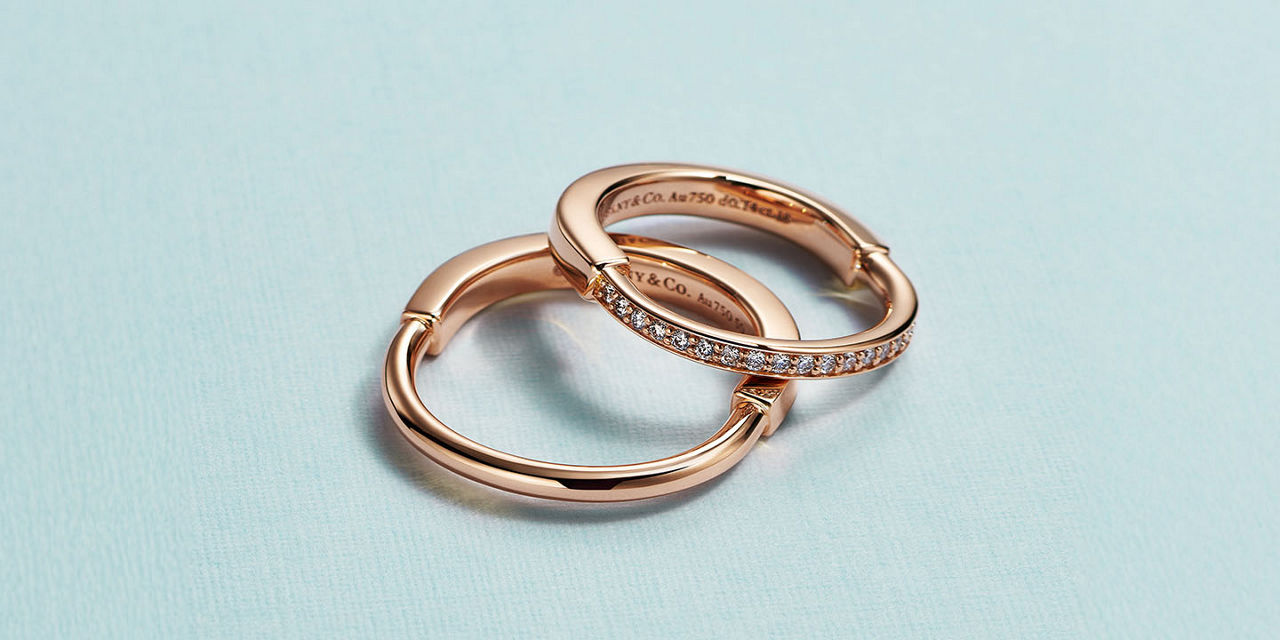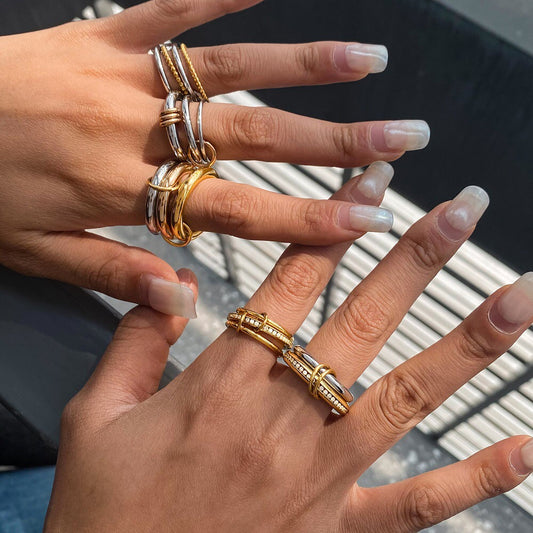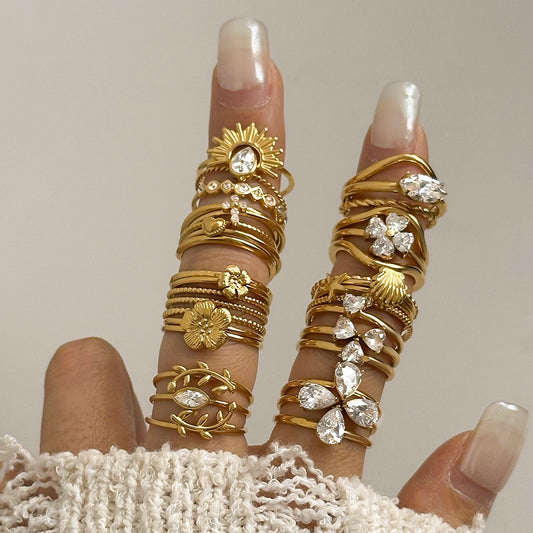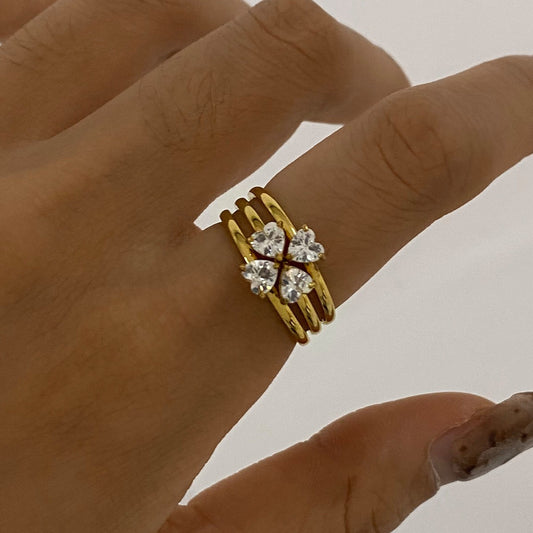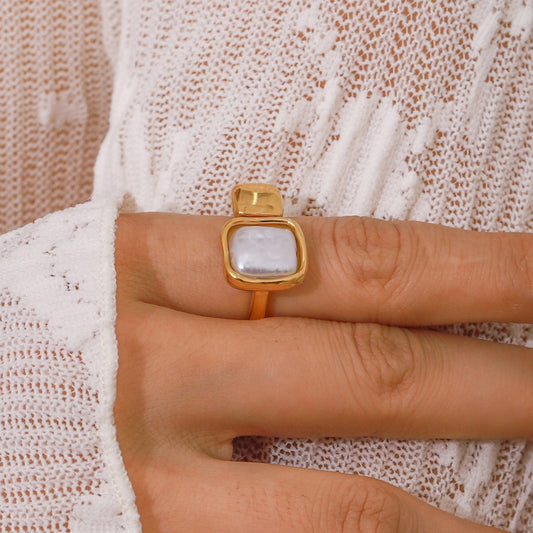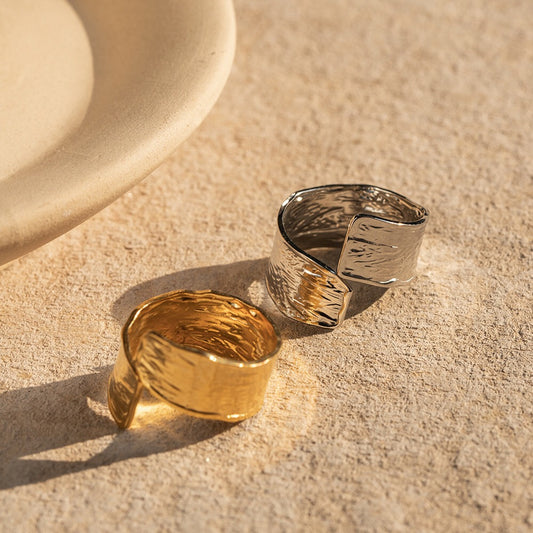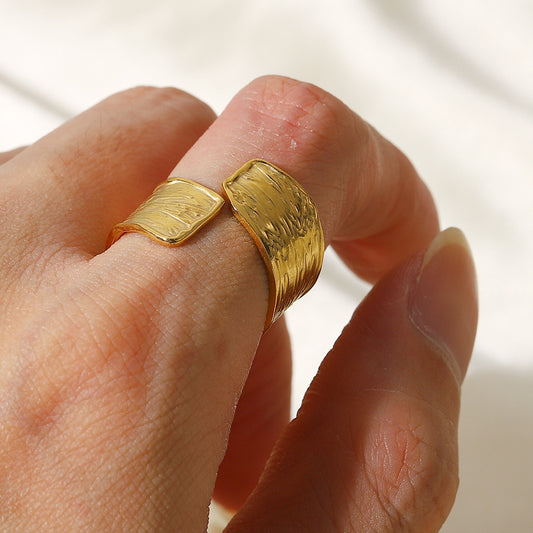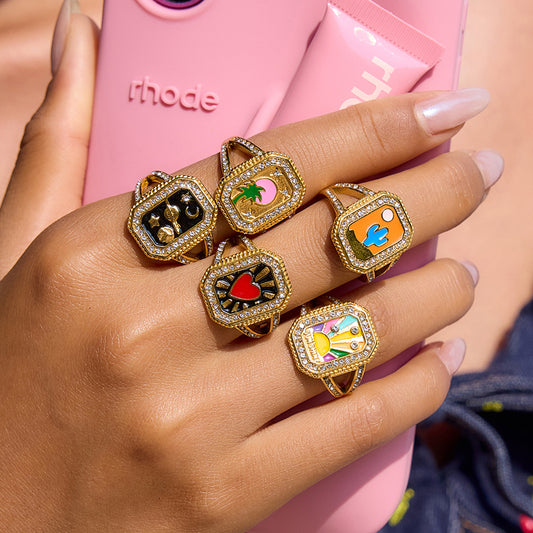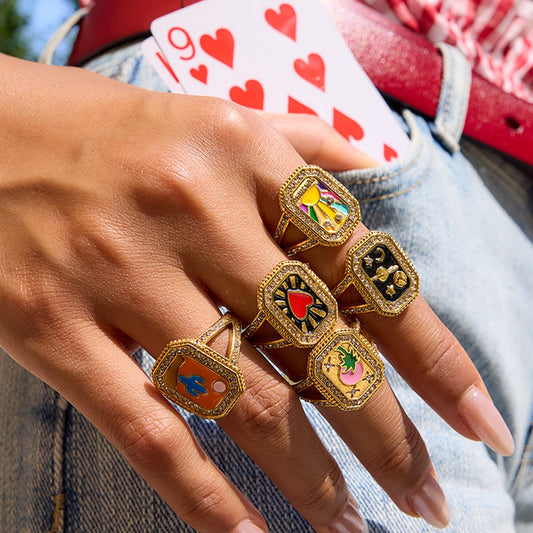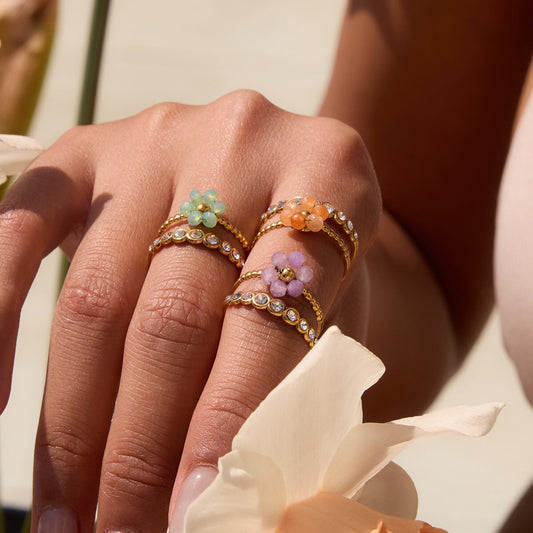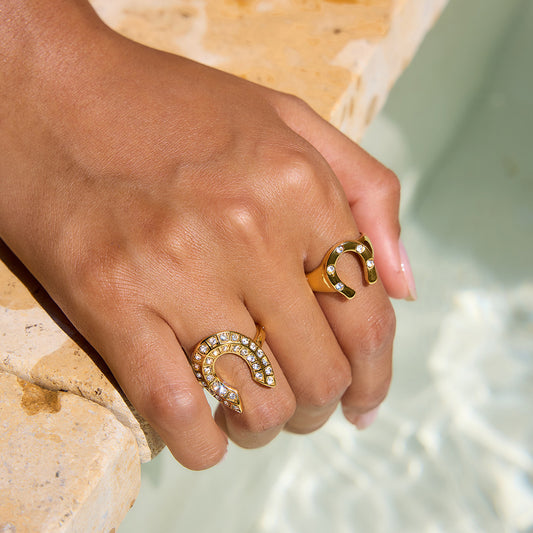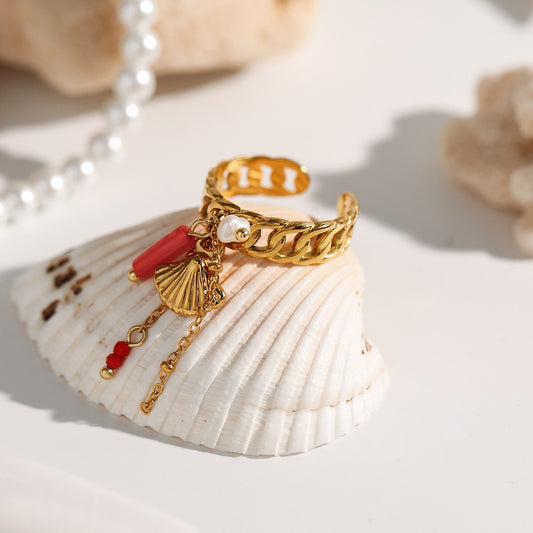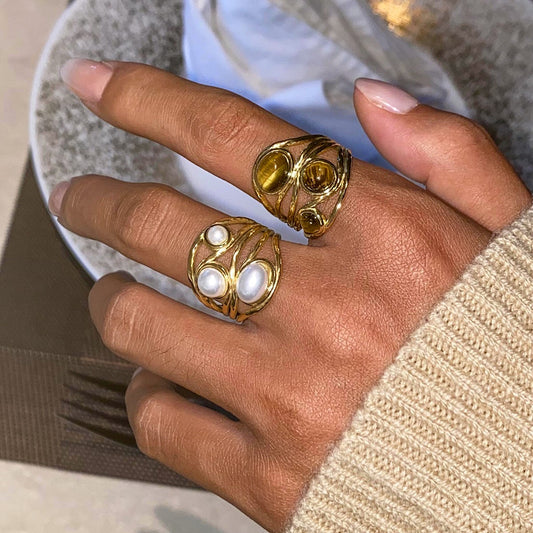Stacked rings have become a defining trend in modern jewelry, and the numbers highlight their growing popularity: according to Etsy’s 2023 Jewelry Trend Report, searches for “stacked rings” increased by 127% year-over-year, with shoppers prioritizing mix-and-match styles that let them personalize their look. The global jewelry market size was estimated at USD 366.79 billion in 2024 and is projected to reach USD 578.45 billion by 2033, growing at a CAGR of 5.3%. Unlike single, statement rings that require careful styling, stacked rings offer a flexible, low-effort way to add sparkle to any outfit—whether you’re heading to work, running errands, or attending a special event. From dainty bands to gemstone-embellished designs, stacked rings turn a simple jewelry choice into a creative expression of style, making them the go-to accessory for anyone looking to elevate their everyday look.

What is Stacked Rings
Core Definition and Styling Concept
Stacked rings refer to the practice of wearing multiple rings on one or more fingers, layered together to create a cohesive, personalized look. Unlike matching ring sets (which are designed to be worn together), stacked rings are typically a mix of different styles, widths, metals, or textures—think a thin gold band paired with a tiny diamond ring and a textured silver band. The goal is to balance variety and harmony: each ring adds visual interest, but the overall stack feels intentional, not cluttered.
Key Differences from Traditional Ring Styling
Traditional ring styling often focuses on one focal ring (e.g., an engagement ring or a statement cocktail ring) with no additional rings on the same finger. Stacked rings, by contrast, embrace layering as the star of the look. Another key difference is flexibility: traditional sets are fixed, while stacked rings let you swap pieces seasonally, mix metals (gold, silver, rose gold), or add meaningful rings (birthstones, engravings) to tell a personal story. This adaptability is what makes stacked rings a favorite among jewelry lovers.
Why is Stacked Rings so Popular
Versatility for Every Outfit and Occasion
Stacked rings work with every style—casual, professional, formal, or bohemian. Pair a stack of thin silver bands with jeans and a tee for a laid-back vibe, or mix gold and diamond rings with a blazer for a polished office look. For weddings or parties, add a gemstone ring to your stack to boost sparkle. Unlike other accessories that only fit specific outfits, stacked rings transition seamlessly, saving you time and simplifying your jewelry routine.
Personalization and Storytelling
Stacked rings let you curate a look that’s uniquely yours. Many people include meaningful pieces in their stacks: a birthstone ring for a child, an engraved band with a partner’s initials, or a tiny ring to mark a milestone (like a promotion or graduation). Each ring becomes a part of your story, turning a simple stack into a wearable memory book. This personal touch makes stacked rings feel more special than generic jewelry.
Affordability and Accessibility
You don’t need a big budget to build a stunning stack. Unlike expensive statement rings, stacked rings can include affordable pieces—think \(20 thin bands from fast-fashion brands paired with one or two higher-quality pieces (like a \)100 diamond accent ring). This “mix of price points” approach lets you grow your stack over time, adding new rings as you find styles you love. Plus, stacked rings are widely available online and in stores, from Zara to Tiffany, so there’s an option for every budget.
Low-Maintenance Style
Stacked rings require minimal effort to look great. You can leave your stack on daily (no need to take it off for most activities) and it will still look polished. Unlike delicate necklaces or bracelets that tangle or break easily, rings are durable and low-fuss. This “set-it-and-forget-it” quality makes stacked rings perfect for busy people who want to look put-together without spending time on styling.

Popular Styles of Stacked Rings
Dainty Band Stacks
Dainty band stacks are made of thin, simple rings (usually 1-2mm wide) in metals like gold, silver, or rose gold. They’re perfect for beginners because they’re subtle and easy to mix. Popular dainty styles include plain polished bands, hammered texture bands, and tiny dot or line engravings. A stack of 3-4 dainty bands on one finger adds a soft, elegant glow without feeling overwhelming.
Gemstone Accent Stacks
Gemstone accent stacks feature 1-2 rings with small gemstones (like diamonds, sapphires, or birthstones) paired with plain bands. The gemstone ring acts as the focal point, while the plain bands add depth. For example, a tiny diamond solitaire ring paired with two thin gold bands creates a classic, timeless stack. This style works for both everyday wear and special occasions, adding a pop of color or sparkle.
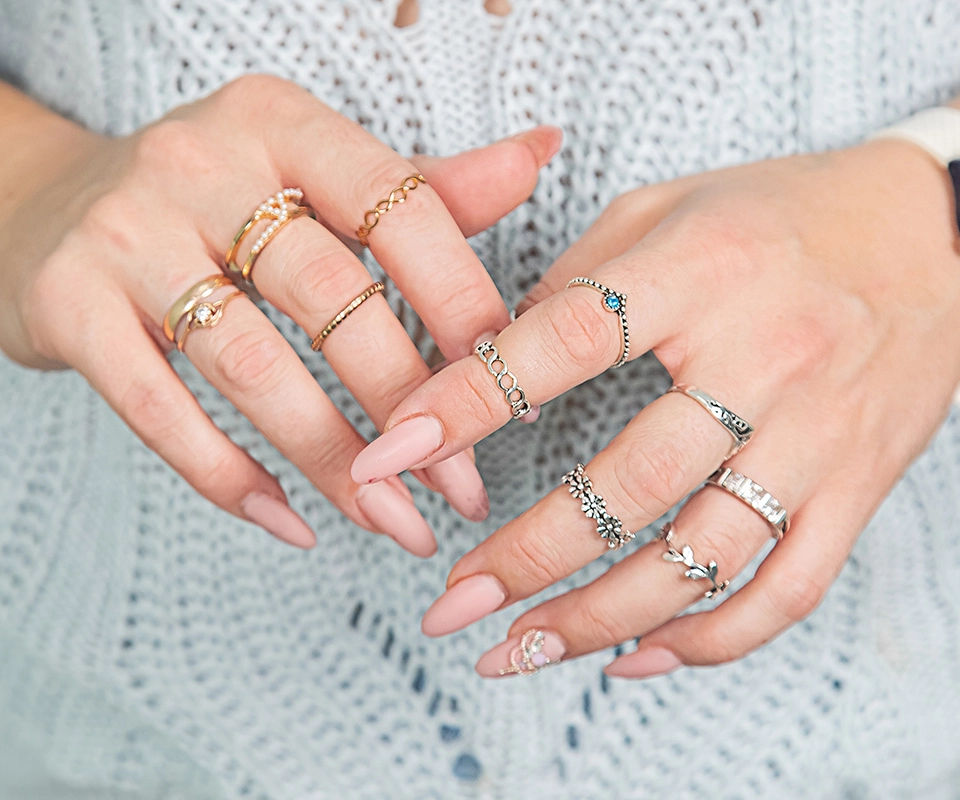
Mixed-Metal Stacks
Mixed-metal stacks combine gold, silver, and rose gold for a modern, eclectic look. The key is balance: pair a silver band with a rose gold band and a thin gold band to avoid clashing. Mixed-metal stacks are great for people who love to experiment—they work with any outfit color and let you reuse rings you already own (even if they’re different metals).
Bold Statement Stacks
Bold statement stacks feature wider rings (3-5mm) with eye-catching details, like thick textured bands, large gemstones, or unique shapes (e.g., geometric or curved designs). These stacks are perfect for people who want to make a style statement—try a thick hammered gold band paired with a wide silver ring with a colored gemstone. Bold stacks work best on larger fingers (like the middle or index finger) to avoid looking bulky.
How to Wear Stacked Rings
Choosing the Right Fingers to Stack
Not all fingers are ideal for stacking—here’s how to choose:
-
Middle Finger: The longest finger, so it can handle 3-4 rings (great for bold or dainty stacks).
-
Ring Finger: Traditionally for engagement/wedding rings, but adding 1-2 thin bands next to them creates a subtle stack.
-
Index Finger: A trendy choice for 2-3 rings—perfect for bold or mixed-metal stacks.
-
Pinky Finger: Best for 1-2 small rings (like a tiny dainty band or a minimalist gemstone ring) for a subtle accent.
Avoid stacking on the thumb unless you’re using wide, comfortable rings—thumbs move a lot, so narrow rings may spin or feel uncomfortable.
Balancing Ring Widths and Textures
The key to a polished stack is balancing widths and textures:
-
Mix Widths: Pair thin bands (1mm) with medium bands (2-3mm) to create depth—avoid stacking all wide rings (it looks bulky).
-
Mix Textures: Combine smooth polished bands with hammered or engraved bands for visual interest. For example, a smooth gold band + a hammered silver band + a tiny diamond band = a balanced, stylish stack.
-
Limit Bold Pieces: If you have one wide, textured ring, pair it with 1-2 thin plain rings to keep the stack from feeling chaotic.
Pairing with Other Jewelry
Stacked rings work well with other jewelry, but keep it cohesive:
-
Earrings: If your stack is bold, wear small studs or hoops. If your stack is dainty, you can wear statement earrings (like drop earrings).
-
Necklaces: Pair stacked rings with a minimalist necklace (like a thin chain) to avoid overcrowding your upper body.
-
Bracelets: A simple bracelet (like a thin bangle) complements stacked rings—avoid chunky bracelets that compete for attention.
Stacked Rings: Perfect Gift for Your Girlfriend
Why It’s a Thoughtful Gift Choice
Stacked rings make a great gift for your girlfriend because they’re personal, versatile, and long-lasting:
-
Personalization: You can choose rings that reflect her style—if she loves minimalism, get a set of dainty gold bands; if she’s bold, pick a gemstone accent ring.
-
Usability: She’ll wear them every day, unlike other gifts that sit in a drawer.
-
Growth: She can add to the stack over time, making the gift feel ongoing (you can even give her a new ring for future occasions!).
Top Gift-Worthy Stacked Ring Styles
-
Birthstone Stack Set: A set of 2-3 thin bands, including one with her birthstone. Add a tiny engraved band with her initials for extra sentiment.
-
Mixed-Metal Starter Set: A set of 3-4 dainty bands in gold, silver, and rose gold—perfect for beginners who want to experiment.
-
Minimalist Diamond Stack: A tiny diamond solitaire ring paired with two thin gold bands—timeless and elegant, great for anniversaries.
Tips for Choosing the Right Size
To ensure the rings fit:
-
Check Her Existing Rings: Borrow one of her rings (that fits the finger you’re shopping for) and measure its inner diameter with a ruler. Use a ring size chart online to find her size.
-
Opt for Adjustable Rings: If you’re unsure of her size, choose adjustable bands (many dainty rings have a small gap that lets you resize them slightly).
-
Ask for Sizing Help: Most jewelry stores offer free ring sizing—if you’re buying in person, bring her along (or use a sizing tool to measure her finger when she’s not looking!).
How to Clean Stacked Rings
Daily Care to Prevent Damage
Keep your stacked rings looking new with daily care:
-
Remove Before Activities: Take off your rings before washing dishes, showering, swimming, or applying lotion/perfume. Chemicals and water can dull metals or loosen gemstones.
-
Wipe After Wear: Use a soft microfiber cloth to wipe each ring after wearing it—this removes oils and dirt that cause tarnish.
-
Store Separately: When you take off your stack, separate the rings (use a jewelry tray with small compartments) to avoid scratching or tangling.
DIY Cleaning Methods for Different Metals/Gemstones
Clean your stacked rings at home with these metal-specific methods:
-
Gold/Silver/Rose Gold Rings: Mix warm water with a few drops of mild dish soap. Soak the rings for 10 minutes, then gently scrub with a soft-bristled toothbrush (avoid scrubbing gemstones too hard). Rinse with cool water and pat dry.
-
Diamond or Hard Gemstone Rings (Sapphire, Ruby): Use the same soapy water method, but you can gently scrub the gemstones to remove dirt from settings.
-
Soft Gemstone Rings (Opal, Pearl): Avoid soaking—wipe with a damp cloth dipped in soapy water, then dry immediately. Soft gemstones are prone to damage from water.
Professional Cleaning for Delicate Pieces
For delicate stacked rings (like those with small gemstones or thin bands), professional cleaning is a good idea every 6-12 months:
-
Jewelry Stores: Most jewelers offer free or low-cost cleaning. They use ultrasonic cleaners to remove dirt from hard-to-reach settings without damaging metals or gemstones.
-
At-Home Ultrasonic Cleaners: If you wear your stack daily, invest in a small ultrasonic cleaner (\(30-\)50) for regular deep cleaning. Follow the instructions carefully—avoid using it for soft gemstones.
How to Stack Rings
Step 1: Start with a Focal Ring
Begin your stack with a focal ring—a piece that stands out (like a gemstone ring, an engraved band, or a textured ring). This ring will be the “star” of your stack, so choose one you love. For example, if you’re making a casual stack, your focal ring could be a hammered silver band. For a formal stack, it could be a tiny diamond ring.
Step 2: Add Complementary Bands
Next, add 1-3 complementary bands to your focal ring. These should be simpler than the focal ring to avoid competition. For example:
-
Focal ring: Tiny diamond solitaire → Complementary bands: Thin gold band + thin silver band.
-
Focal ring: Thick hammered gold band → Complementary bands: 1 thin plain gold band.
Stick to 2-4 rings total per finger—more than that looks cluttered.
Step 3: Balance Metals and Textures
Finally, check that your stack has balanced metals and textures:
-
If your focal ring is gold, add 1 silver or rose gold band to mix metals (but don’t add more than 2 metals total).
-
If your focal ring is smooth, add 1 textured band (like hammered) to add interest.
-
Step back and look at the stack—does it feel balanced? If one side looks heavier, swap a wide band for a thin one.
How to Keep Stacked Rings from Spinning
Choose the Right Size
The #1 reason rings spin is that they’re too big. A properly fitting ring should slide onto your finger easily but stay in place without spinning. If your ring is too big, take it to a jeweler to get resized (most jewelers offer this service for \(10-\)30). For adjustable rings, tighten the gap slightly to fit your finger.
Use Ring Sizers or Spacers
If resizing isn’t an option, use these quick fixes:
-
Ring Sizers: Small, clear plastic or metal sizers that fit inside the ring to make it smaller. They’re affordable (\(5-\)10) and easy to use—just slide one onto the inside of the ring.
-
Spacers: Thin, plain bands that you wear next to the spinning ring. The spacer acts as a “stopper,” keeping the ring from moving. For example, if your diamond ring spins, wear a thin gold band next to it.
Opt for Wide or Textured Bands
Wide bands (3mm+) and textured bands (hammered, engraved) grip your finger better than thin, smooth bands. If you struggle with spinning, swap thin rings for wider ones—they’ll stay in place longer.
How to Stack Rings with Engagement Ring
Keep the Engagement Ring as the Focal Point
Your engagement ring should be the star of the stack, so follow these rules:
-
Place It in the Middle: Wear the engagement ring between 1-2 thin bands (e.g., thin gold band → engagement ring → thin silver band). This draws attention to the engagement ring.
-
Choose Simple Complementary Bands: Avoid bold or sparkly bands that compete with the engagement ring. Stick to plain metals (gold, silver) or tiny gemstones (smaller than your engagement ring’s stone).
Matching Metals to the Engagement Ring
-
If your engagement ring is white gold or platinum: Pair it with silver or white gold bands.
-
If it’s yellow gold: Pair it with yellow gold or rose gold bands (rose gold adds warmth without clashing).
-
If it’s rose gold: Pair it with rose gold or yellow gold bands (avoid silver—it can look mismatched).
Avoid Overcrowding
Never wear more than 3 rings total on the engagement ring finger (engagement ring + 2 thin bands). Too many rings will make the engagement ring look small and cluttered.
How to Stack Wedding Rings
Traditional Stack: Wedding Band + Engagement Ring
The classic stack is the wedding band next to the engagement ring. Here’s how to style it:
-
Order Matters: Wear the wedding band closest to your palm (it symbolizes your commitment), then the engagement ring on top.
-
Match Metals: Choose a wedding band in the same metal as your engagement ring (e.g., white gold wedding band with white gold engagement ring) for a cohesive look.
-
Add a Thin Accent Band (Optional): If you want more sparkle, add a thin diamond accent band on top of the engagement ring. Keep it tiny (1mm) so it doesn’t overshadow the wedding and engagement rings.
Modern Stack: Mixing Wedding Bands
For a modern look, mix 2-3 wedding bands (instead of just one):
-
Example 1: Thin plain gold band + thicker hammered gold band + engagement ring (all yellow gold).
-
Example 2: White gold wedding band + rose gold thin band + white gold engagement ring.
The key is to keep the bands in the same metal family (e.g., all gold tones or all white metals) to avoid looking messy.
Stacking on Multiple Fingers
If you don’t want to stack all rings on one finger, spread them out:
-
Wear the wedding band and engagement ring on the ring finger.
-
Add 1 thin band on the middle finger (same metal as the wedding set) for a coordinated look.
This keeps the focus on the wedding set while adding subtle sparkle to another finger.
Stacked Rings: Your Easy Path to Sparkle (and Next Jewelry Must-Have)
Stacked rings are more than a trend—they’re a flexible, personal way to add sparkle to every day. Whether you’re a beginner building your first stack or a pro mixing metals and gemstones, stacked rings let you express your style without the fuss. From pairing them with engagement rings to gifting them to a loved one, they work for every occasion and every budget.
Ready to create your perfect stack? Explore our curated collection of stacked ring sets today—from dainty metal bands to gemstone accents, we have everything you need to start stacking. Don’t wait—add a little sparkle to your everyday look with stacked rings that are as unique as you are!


